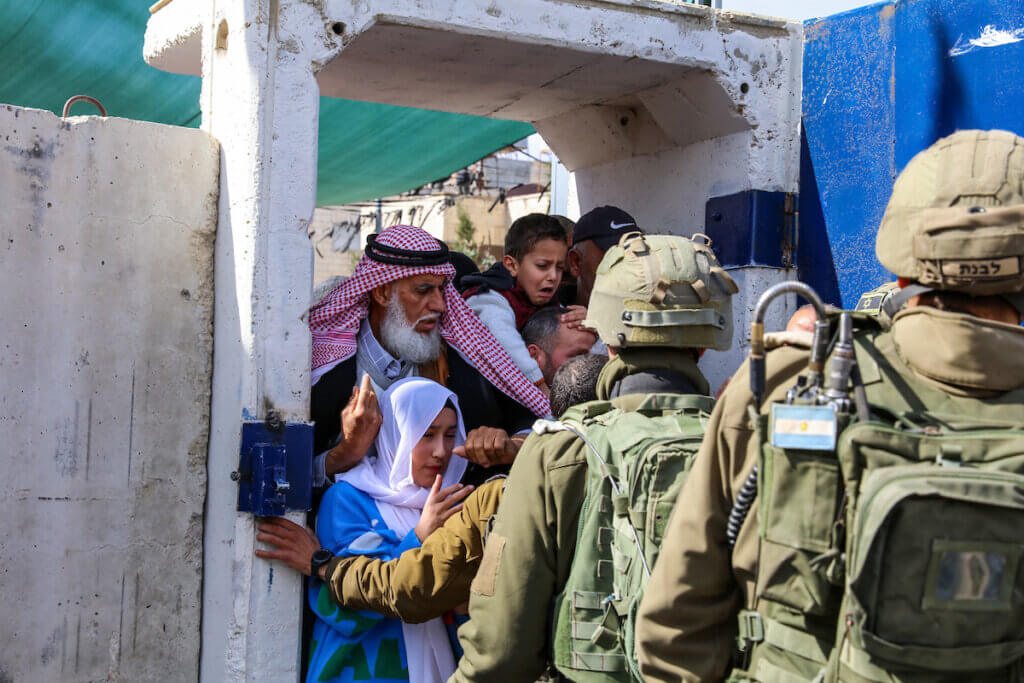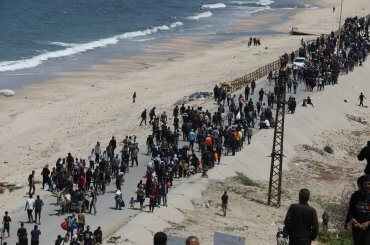THE FIRST 54 YEARS
An Abbreviated Manual for Military Occupation
directed by Avi Moghrabi
110 min. Les Films d’Ici 2021
In his film, “The First 54 Years: An Abbreviated Manual for Military Occupation,” celebrated Israeli filmmaker Avi Mograbi uses an innovative approach to expose the increasingly brutal tactics that Israel has used in its occupation of the West Bank and Gaza since 1967.

“You have occupied the territory, now what?” asks the film’s self-described “Machiavellian occupation expert” as he begins to read from his manual for military occupation.
As the film’s disimpassioned narrator — he sits in an armchair, smoking a cigarette — Mograbi begins, “I will be your guide in this abbreviated manual for military occupation. I will endeavor to discuss some fundamental principles for the maintenance of the military occupation of a territory.”
Following the film’s brief introduction of Israel’s occupation of the Palestinian territory following the ’67 war — and the UN Security Council Resolution 242 requiring Israel to leave the territory — Mograbi delivers his first “instructions” as if to a company of soldiers.
Let’s be frank. One of the biggest problems you have with the population is that you don’t know it. The total majority of your people in the field don’t even speak its language. You can, however, assume that, as with any other population that is not sympathetic to its ruler, this one is bound by solidarity. They care for and support one another. Your job is to disrupt and annihilate it. The Romans called it “Divide and Rule.” There are 1,001 ways to do it.
What follows manifests the film’s second and third devices. After Mograbi reads as if from the manual — in a conversation with Mondoweiss he described his role in the film as a “Machiavellian occupation expert” — clips of former Israeli soldiers describe some of the “1,001 ways” Israel has used to suppress the Palestinian people. The testimonies of the veterans, all members of Breaking the Silence, are then followed by Breaking the Silence archival footage, displaying the atrocities.
The pattern is repeated throughout the film, deployed in an understated way and to great effect.
While for years, Breaking the Silence members recorded their witnesses anonymously, we see the names and faces of scores of soldiers who served following the Second Intifada — including former IDF senior officials. They tell their stories matter-of-factly, sometimes coming across as self-serving and excusing, often as distanced from their violations of human rights and international law, only infrequently reflecting a sense of shame. Their testimonies are backed by striking, always moving, often horrendous video clips revealing the violence.
Viewers are exposed to many of the psychological and physical methods Israel has employed since 1967: mapping, sterilization (of an area), deterrence fire, transit toll, “Break their arms and legs”, “Dry them out”, “Ruin his day”, and Waqef, Boom! (Stop, Bullet!).
One of the chilling first-person testimonies describes the practice of “verifying a kill”:
As [Israeli] soldiers, verifying a kill begins in basic training. You learn that after you take a hill or some other feature on the ground, you scan the route you took there. If you see an enemy, someone who was injured during your raid or attack, you put a bullet in his head. I sometimes hear on the news that the IDF says, “There’s no such thing as ‘verifying a kill.’ It’s not in our lexicon.” It’s so funny, because we heard from almost our first day in the army, “You verify a kill… Anyone you see gets a bullet in the head.”
Viewers are shown abhorrent “trophy” photos of troops standing triumphantly over the bodies of slain Palestinians.
Addressing Israel’s disengagement from Gaza (the evacuation of the 21 Jewish settlements in the Strip) Mograbi — as the detached instructor — says,
And last but not least… [g]iven that you cannot afford to expel the local population, the numerical relation of settlers to occupied inhabitants becomes significant. The moment comes when it’s clear that in certain areas this demographic balance cannot be sufficiently engineered to your favor. Then in these areas painful decisions have to be taken. Sacrificing a knight to save a king is one possible move. Repatriating your fellow countrymen back to your country, destroying everything you built. You don’t want to leave the enemy with anything they can benefit from. Withdraw your troops and just leave. Lock the door really tight behind. Lock down the area with your military. Don’t look back. At this moment, you say to yourself, “The occupation of this area has terminated. This is war now.”
Videos of Israeli Defense Forces engineering teams destroying settlement homes are followed by descriptions of Operation Cast Lead and Operation Protective Edge as Israel turned to the destruction of Gaza and its people.
Asked how he arrived at this way of describing Israel’s now 56-year occupation, Mograbi said he realized that the Breaking the Silence video archive — gathered since the founding of the organization in 2004 — “could cover a larger story than what Breaking the Silence normally does… publishing one or two of [the testimonies] under a certain theme.” The idea of the manual and his aloof presentation came after he put the many chosen clips together in chronological order.
The film was presented by Voices from the Holy Land (VFHL), which hosted a panel discussion last month after people had been given the opportunity to view the film. Asked why VFHL chose “The First 54 Years,” Deepak Kenkeremath, one of VFHL’s organizers, said,
Apartheid is enforced by state-sponsored terror and daily violence against the oppressed peoples. Much of that violence is unseen by the rest of the world. VFHL chose “The First 54 Years: An Abbreviated Manual for Military Occupation” because it raises the curtain. It examines the anatomy of this violence in clinical detail…. Most people, both inside and outside Israel, we believe, are unaware of this reality.
“The First 54 Years” is a comprehensive, chronological, compelling, fact-based, heart-breaking presentation of the methodology and practices of Israel’s occupation. If film festivals focusing on Israel’s colonial-apartheid regime are looking for entries, “The First 54 Years” should be at the top of the list.
Still, when asked about his hope for the film, Mograbi said, “As to the film’s effect, I’m not as naïve as I was when I started making my films.” While acknowledging that his films “strengthen the already existing anti-occupation community,” he said, “Films don’t change the world. But films sometimes support and encourage us, people of the left, of the anti-occupation block.”
Mograbi’s films are available to view online.
You can register here to view VFHL’s next film, The Truth: LOST at SEA, and to participate in the August 20 panel discussion.



So far as I can tell, the film is not available online using the link from Mr Mograbi’s site. The link goes to a Facebook page which states: ‘This video is no longer available’. Two other of his films are viewable on YouTube.
“destroying everything you built. You don’t want to leave the enemy with anything they can benefit from”
An old friend, a Christian, was a supporter of Israel until they destroyed the housing they had built for settlers in Gaza, instead of leaving it for the Gazans to use. “What a waste!” (I think she didn’t realize they had scattered the rubble over what had been farmers’ fields, creating even more waste.)